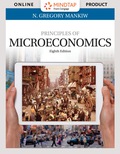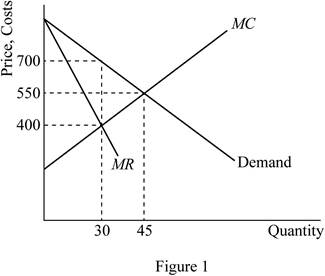
Subpart (a):
Revenues, costs and profits.
Subpart (a):
Explanation of Solution
Table -1 shows the total quantity and respective
Table -1
| Price | Quantity |
| 100 | 0 |
| 90 | 100,000 |
| 80 | 200,000 |
| 70 | 300,000 |
| 60 | 400,000 |
| 50 | 500,000 |
| 40 | 600,000 |
| 30 | 700,000 |
| 20 | 800,000 |
| 10 | 900,000 |
| 0 | 1,000,000 |
Total revenue can be calculated by using the following formula.
Substitute the respective values in Equation (1) to calculate the total revenue at price $90.
Total revenue is $9,000,000.
Total cost can be calculated by using the following formula.
Substitute the respective values in Equation (2) to calculate the total cost at quantity 100,000 units.
Total cost is $2,000,000.
Profit can be calculated by using the following formula.
Substitute the respective values in Equation (3) to calculate the profit for the quantity 100,000 units.
Profit is 7,000,000.
Table -2 shows the total revenue, total cost and profit that are obtained by using Equations (1), (2) and (3).
Table -2
| Price | Quantity | Total revenue | Total cost | Profit |
| 100 | 0 | 0 | 2,000,000 | -2,000,000 |
| 90 | 100,000 | 9,000,000 | 3,000,000 | 6,000,000 |
| 80 | 200,000 | 16,000,000 | 4,000,000 | 12,000,000 |
| 70 | 300,000 | 21,000,000 | 5,000,000 | 16,000,000 |
| 60 | 400,000 | 24,000,000 | 6,000,000 | 18,000,000 |
| 50 | 500,000 | 25,000,000 | 7,000,000 | 18,000,000 |
| 40 | 600,000 | 24,000,000 | 8,000,000 | 16,000,000 |
| 30 | 700,000 | 21,000,000 | 9,000,000 | 12,000,000 |
| 20 | 800,000 | 16,000,000 | 10,000,000 | 6,000,000 |
| 10 | 900,000 | 9,000,000 | 11,000,000 | -2,000,000 |
| 0 | 1,000,000 | 0 | 12,000,000 | -12,000,000 |
The maximum profit of $18 million is obtained at a quantity of 500,000 at a price of $50. Thus, the
Concept introduction:
Profit: Profit refers to the excess revenue after subtracting the total cost from the total revenue.
Total revenue: Total revenue refers to the revenue of a firm through its total sale of goods.
Total cost: Total cost refers to the cost of all the inputs used by the firm. It includes both the fixed cost and the variable costs.
Subpart (b):
Calculate marginal revenue.
Subpart (b):
Explanation of Solution
Marginal revenue can be calculated as follows:
Substitute the respective values in equation (4) to calculate the marginal revenue at price level $60.
Marginal revenue is $30.
Table -3 shows the marginal revenue that obtained by using equation (4).
Table -3
| Price | Quantity | Total revenue | Marginal revenue |
| 100 | 0 | 0 | - |
| 90 | 100,000 | 9,000,000 | $90 |
| 80 | 200,000 | 16,000,000 | 70 |
| 70 | 300,000 | 21,000,000 | 50 |
| 60 | 400,000 | 24,000,000 | 30 |
| 50 | 500,000 | 25,000,000 | 10 |
| 40 | 600,000 | 24,000,000 | -10 |
| 30 | 700,000 | 21,000,000 | -30 |
| 20 | 800,000 | 16,000,000 | -50 |
| 10 | 900,000 | 9,000,000 | -70 |
| 0 | 1,000,000 | 0 | -90 |
From table 4, it can be inferred that Marginal Revenue is less than price. Since the demand curve slopes downwards, Price declines when quantity rises. The marginal revenue declines even more than price because the firm loses revenue on all the units of the good sold when it lowers the price.
Concept introduction:
Marginal revenue: Marginal revenue refers to the amount of extra revenue attained in the process of increasing one more unit of output.
Subpart (c):
Profit maximization.
Subpart (c):
Explanation of Solution
Figure 1illustrates the

Figure 1 represents the marginal-revenue, marginal-cost, and demand curves. The horizontal axis represents the quantity and the vertical axis the prices, revenues and costs. The MR and MC curves cross between quantities of 400,000 and 500,000 which signify that the firm is maximizing profit in that region.
Concept introduction:
Marginal product of labor (MPL): Marginal product of labor refers to the additional output produced due to employing one more unit of labor.
Marginal product of capital (MPC): Marginal product of capital refers to the additional output produced due to employing one more unit of capital.
Profit maximization: A firm can maximize its profit at the point where its marginal revenue is equal to marginal cost.
Subpart (d):
Deadweight loss.
Subpart (d):
Explanation of Solution
The deadweight loss is depicted by area DWL in figure 1. Deadweight loss is greater in
Concept introduction:
Deadweight loss: Deadweight loss refers to loss of total economic benefit that arises due to the inefficient allocation of resource.
Subpart (e):
Change in profit.
Subpart (e):
Explanation of Solution
The price would not change if the author were paid $3 million instead of $2 million, the publisher since there would be no change in marginal cost or marginal revenue. The result would be a fall in the firm’s profit.
Concept introduction:
Profit: Profit refers to the excess revenue after subtracting the total cost from the total revenue.
Subpart (f):
Maximize economic efficiency.
Subpart (f):
Explanation of Solution
To maximize economic efficiency, the publisher would charge the price at $10 per book. This is because it is the marginal cost of the book. At price $10 per book, the publisher would receive negative profits equal to the amount paid to the author.
Concept introduction:
Economic efficiency: Economic efficiency is the situation where the economy is efficient. Which means that the marginal benefit from the last unit produced is equal to the marginal cost of production and the economic surplus will be at maximum.
Want to see more full solutions like this?
Chapter 15 Solutions
ECNS 201 PRINTOUT
- Consider the figure at the right. The profit of the single-price monopolist OA. is shown by area D+H+I+F+A. B. is shown by area A+I+F. OC. is shown by area D + H. ○ D. is zero. ○ E. cannot be calculated or shown with just the information given in the graph. (C) Price ($) B C D H FIG шо E MC ATC A MR D = AR Quantityarrow_forwardConsider the figure. A perfectly price-discriminating monopolist will produce ○ A. 162 units and charge a price equal to $69. ○ B. 356 units and charge a price equal to $52 for the last unit sold only. OC. 162 units and charge a price equal to $52. OD. 356 units and charge a price equal to the perfectly competitive price. Dollars per Unit $69 $52 MR 162 356 Output MC Darrow_forwardThe figure at right shows the demand line, marginal revenue line, and cost curves for a single-price monopolist. Now suppose the monopolist is able to charge a different price on each different unit sold. The profit-maximizing quantity for the monopolist is (Round your response to the nearest whole number.) The price charged for the last unit sold by this monopolist is $ (Round your response to the nearest dollar.) Price ($) 250 225- 200- The monopolist's profit is $ the nearest dollar.) (Round your response to MC 175- 150 ATC 125- 100- 75- 50- 25- 0- °- 0 20 40 60 MR 80 100 120 140 160 180 200 Quantityarrow_forward
- The diagram shows a pharmaceutical firm's demand curve and marginal cost curve for a new heart medication for which the firm holds a 20-year patent on its production. At its profit-maximizing level of output, it will generate a deadweight loss to society represented by what? A. There is no deadweight loss generated. B. Area H+I+J+K OC. Area H+I D. Area D + E ◇ E. It is not possible to determine with the information provided. (...) 0 Price 0 m H B GI A MR MC D Outparrow_forwardConsider the figure on the right. A single-price monopolist will produce ○ A. 135 units and charge a price equal to $32. B. 135 units and generate a deadweight loss. OC. 189 units and charge a price equal to the perfectly competitive price. ○ D. 189 units and charge a price equal to $45. () Dollars per Unit $45 $32 MR D 135 189 Output MC NGarrow_forwardSuppose a drug company cannot prevent resale between rich and poor countries and increases output from 3 million (serving only the rich country with a price of $80 per treatment) to 9 million (serving both the rich and the poor countries with a price of $30 per treatment). Marginal cost is constant and equal to $10 per treatment in both countries. The marginal revenue per treatment of increasing output from 3 million to 9 million is equal to ○ A. $20 per treatment, which is greater than the marginal cost of $10 per treatment and thus implies that profits will rise. ○ B. $20 per treatment, which is greater than zero and thus implies that profits will rise. ○ C. $30 per treatment, which is greater than the marginal cost of $10 per treatment and thus implies that profits will rise. ○ D. $5 per treatment, which is less than the marginal cost of $10 per treatment and thus implies that profits will fall. ○ E. $30 per treatment, which is less than the marginal revenue of $80 per treatment…arrow_forward
- Consider the figure. A single-price monopolist will have a total revenue of Single-Price Monopolist OA. 84×$13. O B. 92x $13. OC. 84×$33. OD. 92 x $33. C Price ($) $33 $13 MC MR D 84 92 Output The figure is not drawn to scale.arrow_forward10.As COVID-19 came about, consumers' relationship with toilet paper changed and they found themselves desiring more than usual. Eventually, toilet paper producers saw an opportunity to make more money and meet the growing demand. Which best describes this scenario as depicted in Snell's 2020 article? A. The demand curve shifted left and the supply curve shifted left B. The demand curve shifted left and the supply curve shifted right C. The demand curve shifted right and the supply curve shifted left D. The demand curve shifted right and the supply curve shifted rightarrow_forward5. Supply and Demand. The graph below shows supply and demand curves for annual medical office visits. Using this graph, answer the questions below. P↑ $180 $150 $120 $90 $60 $30 4 8 12 16 20 24 28 32 36 a. If the market were free from government regulation, what would be the equilibrium price and quantity? b. Calculate total expenditures on office visits with this equilibrium price and quantity. c. If the government subsidized office visits and required that all consumers were to pay $30 per visit no matter what the actual cost, how many visits would consumers demand? d. What payment per visit would doctors require in order to supply that quantity of visits? e. Calculate total expenditures on office visits under the condition of this $30 co- payment. f. How do total expenditures with a co-payment of $30 compare to total expenditures without government involvement? Provide a numerical answer. Show your work.arrow_forward
- 4. The table below shows the labor requirements for Mr. and Mrs. Howell for pineapples and coconuts. Which is the most accurate statement? A. Mrs. Howell has a comparative advantage in coconuts and the opportunity cost of 1 coconut for Mrs. Howell is 4 pineapples B. Mrs. Howell has a comparative advantage in pineapples and the opportunity cost of 1 pineapple for Mrs. Howell is .25 coconuts. C. Mr. Howell has a comparative advantage in pineapples and the opportunity cost of 1 pineapple is 1 coconut. D. Mr. Howell has a comparative advantage in both pineapples and coconuts and should specialize in pineapples. Labor Requirements for Pineapples and Coconuts 1 Pineapple 1 Coconut Mr. Howell 1 hour 1 hour Mrs. Howell 1/2 hour 2 hoursarrow_forward4. Supply and Demand. The table gives hypothetical data for the quantity of electric scooters demanded and supplied per month. Price per Electric Scooter Quantity Quantity Demanded Supplied $150 500 250 $175 475 350 $200 450 450 $225 425 550 $250 400 650 $275 375 750 a. Graph the demand and supply curves. Note if you prefer to hand draw separately, you may and insert the picture separately. Price per Scooter 300 275 250 225 200 175 150 250 400 375425475 350 450 550 650 750 500 850 Quantity b. Find the equilibrium price and quantity using the graph above. c. Illustrate on your graph how an increase in the wage rate paid to scooter assemblers would affect the market for electric scooters. Label any new lines in the same graph above to distinguish changes. d. What would happen if there was an increase in the wage rate paid to scooter assemblers at the same time that tastes for electric scooters increased? 1ངarrow_forward3. Production Costs Clean 'n' Shine is a competitor to Spotless Car Wash. Like Spotless, it must pay $150 per day for each automated line it uses. But Clean 'n' Shine has been able to tap into a lower-cost pool of labor, paying its workers only $100 per day. Clean 'n' Shine's production technology is given in the following table. To determine its short-run cost structure, fill in the blanks in the table. Fill in the columns below. Outpu Capita Labor TFC TVC TC MC AFC AVC ATC 1 0 30 1 1 70 1 2 120 1 3 160 1 4 190 1 5 210 1 6 a. Over what range of output does Clean 'n' Shine experience increasing marginal returns to labor? Over what range does it experience diminishing marginal returns to labor? (*answer both questions) b. As output increases, do average fixed costs behave as described in the text? Explain. C. As output increases, do marginal cost, average variable cost, and average total cost behave as described in the text? Explain. d. Looking at the numbers in the table, but without…arrow_forward
 Essentials of Economics (MindTap Course List)EconomicsISBN:9781337091992Author:N. Gregory MankiwPublisher:Cengage Learning
Essentials of Economics (MindTap Course List)EconomicsISBN:9781337091992Author:N. Gregory MankiwPublisher:Cengage Learning Microeconomics: Private and Public Choice (MindTa...EconomicsISBN:9781305506893Author:James D. Gwartney, Richard L. Stroup, Russell S. Sobel, David A. MacphersonPublisher:Cengage Learning
Microeconomics: Private and Public Choice (MindTa...EconomicsISBN:9781305506893Author:James D. Gwartney, Richard L. Stroup, Russell S. Sobel, David A. MacphersonPublisher:Cengage Learning Economics: Private and Public Choice (MindTap Cou...EconomicsISBN:9781305506725Author:James D. Gwartney, Richard L. Stroup, Russell S. Sobel, David A. MacphersonPublisher:Cengage Learning
Economics: Private and Public Choice (MindTap Cou...EconomicsISBN:9781305506725Author:James D. Gwartney, Richard L. Stroup, Russell S. Sobel, David A. MacphersonPublisher:Cengage Learning Principles of Economics 2eEconomicsISBN:9781947172364Author:Steven A. Greenlaw; David ShapiroPublisher:OpenStax
Principles of Economics 2eEconomicsISBN:9781947172364Author:Steven A. Greenlaw; David ShapiroPublisher:OpenStax Managerial Economics: Applications, Strategies an...EconomicsISBN:9781305506381Author:James R. McGuigan, R. Charles Moyer, Frederick H.deB. HarrisPublisher:Cengage Learning
Managerial Economics: Applications, Strategies an...EconomicsISBN:9781305506381Author:James R. McGuigan, R. Charles Moyer, Frederick H.deB. HarrisPublisher:Cengage Learning





